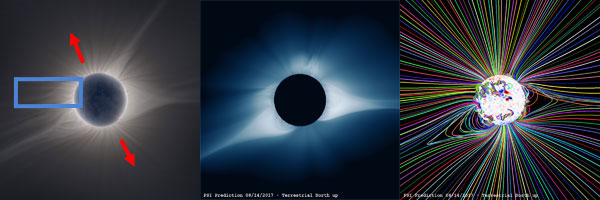Scientists predicted the shape of the solar corona as it would be seen during the August 21, 2017, total solar eclipse. Observations confirmed that they got the broad strokes right.
The Sun is about as easy to study as any astronomical object could be. It’s bright, so there’s no shortage of light to examine; it’s nearby, so even small details on its surface are clear; and for about twelve hours per day, it faces almost no competition for astronomical attention.
But for all its nearness and brightness, the Sun remains mysterious. Ironically, its outermost layer — the corona, an intricate crown of super-heated, diffuse plasma — is the least understood. The corona expresses the hidden magnetic angst of the Sun. Because plasma is made of charged particles, which respond to magnetic influence, the Sun’s magnetic field can twist the corona into loops and bands and prongs.
When the magnetic field, continually pulled and stressed by the Sun’s rotation, erupts, it launches coronal plasma into interplanetary space. This type of space weather threatens satellites, electrical grids, and telecommunications networks, so it’s in our best interest to understand it. Now, solar physicists have shown August 27th in Nature Astronomy that they can accurately predict the appearance of the corona one week in advance — an important milestone on the path to predicting the oncoming solar wind.

Predictive Science Inc. / Miloslav Druckmüller, Peter Aniol, Shadia Habbal / NASA Goddard, Joy Ng
The Once and Future Corona
Zoran Mikić (Predictive Science, Inc.) and collaborators offer a new model of the Sun’s outer layers that’s up to date with the latest theoretical work on how the interior of the Sun heats and magnetically innervates the corona. Mikić and colleagues put this model to the test last year, when they took observations of the Sun on July 16 and August 11, 2017, and let a NASA supercomputer calculate, according to their model, what the solar corona would look like ten days later, during the August 21st total solar eclipse. They then compared these visualizations to actual images taken by ground-based photographers.

Left: Alson Wong / S&T Online Photo Gallery, Center, Right: Predictive Science, Inc.
It’s worth pausing here to emphasize how unusual a study like this is — generally, astronomers study slowly evolving, faraway objects. It’s rare to be able to run a simulation and test its results immediately. The results of the computer run were encouraging: The simulated corona has the same broad shape as its real-life counterpart, with a few bold, bright “streamers” of plasma flowing out into space, as well as intervening loops with small-scale structure similar to those of the real Sun.
While the simulated Sun isn’t perfect, its decent correspondence to the real Sun gives solar astronomers confidence that they’re on the right track to understanding the physics of the Sun’s outer layers. In the sandbox of their simulation, Mikić and collaborators are even able to put solar physics to the test — they noticed, for example, coronal rays extending to the left of the solar disk (highlighted in the blue box in the figure above), which are visually similar to the plumes that burst forth from the Sun’s north and south poles (red arrows). At the poles, this is known to happen because the magnetic field lines extend straight out into space, like the lines that point straight outward from the ends of a bar magnet. To verify that the left-pointing rays had the same physical origin, Mikić and collaborators reached into their simulation, turned off the pole-like parts of the corona, and watched the rays disappear.
Together with new and improved measurements of the Sun’s magnetic field, models like this one could soon “track the continuous evolution of the Sun, similar to what is done in terrestrial weather models,” the authors conclude. With such data coming soon from missions like NASA’s Parker Solar Probe, we’re on track to never being surprised by a solar storm again!
 1
1









Comments
Jon Seamans
September 3, 2018 at 11:35 pm
Very interesting and definitely a milestone for a prediction. Only I'm surprised this result is posted now as this time last year I overlaid the two images and came to the same conclusion. Not seeing a confirmation, I forgot all about this prediction.
You must be logged in to post a comment.
You must be logged in to post a comment.